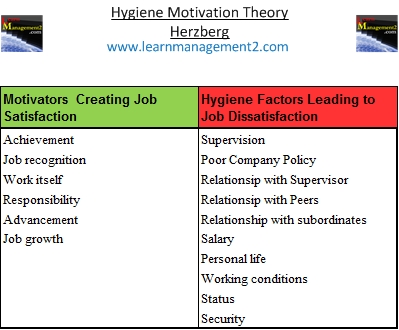Hygiene Motivation Theory
Frederick Herzberg
Introduction
Frederick Herzberg explored the question - What do people want from their jobs?. He did this through asking various people about situations and events at work, when they felt exceptionally good or bad about their jobs. The research showed what led to job satisfaction and the things that created job dissatisfaction. Herzberg used the research to formulate his Hygiene Motivation Theory.
Hygiene Motivation Theory Findings
Herzberg's collection of information revealed that intrinsic factors are related to job satisfaction, whilst extrinsic factors created job dissatisfaction. In other words when people felt satisfied and happy at work the conditions present were directly affecting their inner feelings and self esteem. Yet dissatisfaction was created by the job environment people worked in and the interactions within that environment. This distinction is clearly illustrated in the table below.
The table below provides examples of things that lead to job satisfaction and examples of things which may create employee dissatisfaction.
Is job satisfaction the opposite of job dissatisfaction?
As job satisfaction and job dissatisfaction are controlled by different factors Herzberg concluded that job satisfaction was not the opposite of job dissatisfaction. In contrast to the accepted theories at the time, Herzberg believed that job satisfaction was a distinct and separate entity from job dissatisfaction.
In other words the complete removal of job dissatisfaction will not cause an employee to feel job satisfaction. Similarly job satisfaction does not necessarily eradicate all elements of job dissatisfaction. Herzberg therefore decided that the opposite of job dissatisfaction was simply a work environment containing "no dissatisfaction"; and the opposite of job satisfaction was an employee feeling "no satisfaction".
Conclusion
As extrinsic factors do not motivate employees Herzberg referred to these as Hygiene factors and intrinsic factors were called motivators for obvious reasons. From the 1960s to the 1980’s Herzberg’s theory of motivators and hygiene factors was widely popular. After that other studies labelled it as simplistic but its principles can still be found within other motivation theories.
